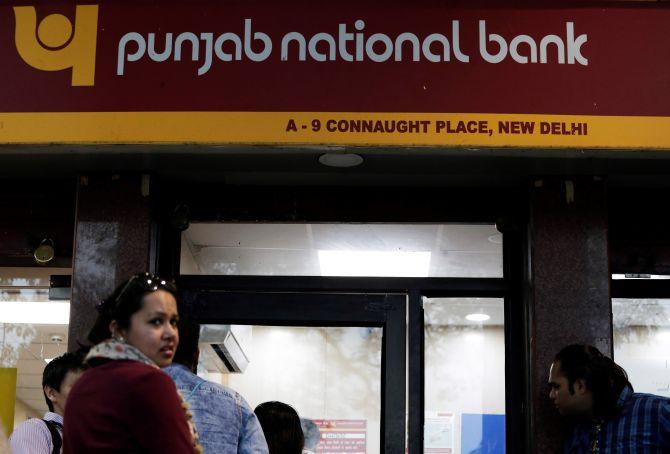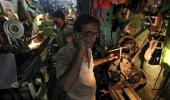'So far, loans outstanding of around Rs 4 trillion, out of the total Rs 7.5 trillion, have been postponed.'

Punjab National Bank's integration with the Oriental Bank of Commerce and the United Bank of India came at a time when the country was in lockdown to mitigate the impact of coronavirus disease.
"We had planned for credit growth of 8 per cent, but because of COVID-19 it will be around 6 per cent," PNB Managing Director and CEO S S Mallikarjuna Rao tells Somesh Jha.
Which sectors have been most affected by COVID-19?
We have seen an impact on apparel and textiles, auto and auto components, aviation, tourism, and financial sectors including non-banking finance companies, building and construction.
We do not have huge exposure to aviation, except Jet Airways, which is already a non-performing asset.
The micro, small and medium enterprises segment will have a problem.
In the apparel sector, the issue is that they import raw material from Bangladesh, manufacture it here and export.
It will take more for them to come back to normalcy and their accounts will be under stress.
What is your outlook?
There can be an impact on profitability as there will be more NPAs.
There will be some slippage, which will have to be accounted for and it will impact profitability.
I am expecting that things will improve from October 1.
So, there will be an impact of 6 months.
How long can we afford a lockdown?
It is not a question of affordability.
We will continue to support our customers in the crisis, but there will be an impact on the credit off-take.
How have your targets changed for this year?
We had planned for credit growth of 8 per cent, but because of COVID-19 it will be around 6 per cent.
On NPAs/slippages, we are keeping our fingers crossed to see how the first two quarters pan out.
We have seen an impact of Rs 4,000 crore, majority of which are MSMEs and retail accounts, for the bank in March, which otherwise wouldn't have been there.
How is the employees's morale given they have to report to work during the lockdown?
There is no doubt that there is pressure to work under these circumstances.
The reason is we are providing services to citizens.
Footfall in branches being less, we are operating with 50 per cent staff so that we can protect their health.
We are maintaining electronic channels efficiently so that customers continue to use it and switch from cash mode.
 We are regularly communicating with employees. I am myself boosting their morale by appreciating their efforts in these tough times.
We are regularly communicating with employees. I am myself boosting their morale by appreciating their efforts in these tough times.
There are some sporadic incidents across the country such as crowds being high in front of the bank branch during the direct benefit transfer, which is a cause of concern for the state authorities, who call up branch managers asking for an explanation or for closing branches.
But by and large, it has been extremely smooth.
Can the operations of branches be rationalised during lockdown?
In some parts, it can be done, but our branch operational ratio right now is 92 to 95 per cent across the country.
How are you preparing for lockdown extension?
As far as banks are concerned, there are no problems as we have sufficient cash; we are calibrating branch activities too.
The impact is on amalgamation.
Effective April 1, certain activities, such as customer and employees's outreach, human resource deployment, which we had planned to complete by April 15 to 30, will be pushed back by a month.
Were some product launches also delayed?
As of today, all our products have been harmonised.
Even though the database is different for three banks, we have customised.
For example, human deployment, changing of the name boards, which was to start from April 1, has been postponed by a month.
How have many customers availed the three-month moratorium on loan repayment?
We have given the facility to all borrowers, except NBFCs.
Opting out is automatic if customers pay the money.
So far, loans outstanding of around Rs 4 trillion, out of the total Rs 7.5 trillion, have been postponed for the merged entity.
Is the bank helping its borrowers in any way to deal with the situation?
We have released four new products: For farmers -- 25 per cent of their existing Kisan Credit Card limits to the maximum of Rs 50,000, we can give money to them by application. They can repay in a span of 3 years.
We have also introduced Tatkal Sahayata Rin for self-help groups, under which we are extending loans to the tune of Rs 5,000 per member and Rs 1 lakh for group, repayable in 3 years.
The third product is a personal loan, equivalent to three times of average monthly salary, up to Rs 3 lakh, and the fourth product is for the bigger group, additional funding to the extent of 10 per cent of working capital without insisting on margin.
These will address cash flow problems.
How are you monitoring slippages of good loans into bad?
If borrowers categorised as Stress Mention Account-2 as of March 1 have not paid money till March 31, they are categorised as NPAs.
We are impressing upon such borrowers that since additional demand for interest is not there for March, April and May, the overdue amount as of March 1 can be paid till May 31 so the account remains standard.
Because of the lockdown, we are trying to reach out to such borrowers by April 30.
How many such borrowers are there?
The SMA-2 accounts, outstanding as of March 1, that have become NPAs for PNB till March 31 are to the tune of Rs 2,000 crore and for the combined entity, are around Rs 4,000 crore.
This wouldn't have happened if the COVID-19 pandemic hadn't hit the country.
But quarterly slippages would not be high.
This loan amount of Rs 4,000 crore has the potential for upgrade so we are reaching out to them.
Industry wants the banking system's help to pay three months's wages of employees by enhancement of working capital loans. How do you see this?
Our fourth product, released three-four days ago, is actually covering wages for up to 6 months for firms.
Now, we have to reach out to customers as they have to be aware of the product.
By April 30, we will have a good number of customers availing it.
Photograph: Saumya Khandelwal/Reuters











